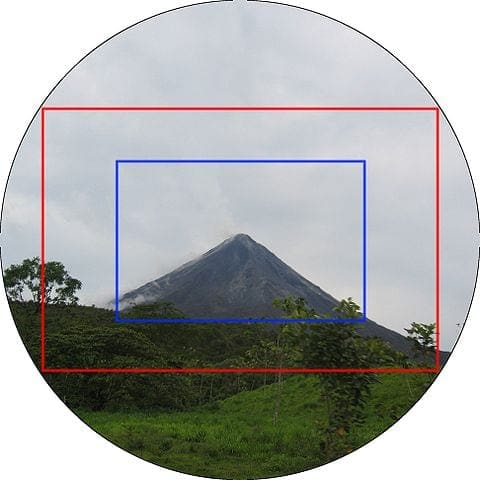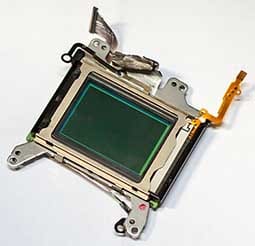With full-frame cameras becoming more ubiquitous and affordable in price, a new generation of digital photographers is waking up to the potential of shooting with high-resolution sensors.
But advances in technology in many crop-sensor cameras (such as Olympus’s Pixel Shift functionality) are allowing photographers who can’t afford – or don’t want to spend the money on – full frame to take equally large images up to 50MB in resolution.
So you might be asking yourself: do I really need a full-frame sensor? What’s the difference between full frame vs APS-C cameras?
Simply put, crop-sensor cameras are those that have image sensors that are smaller than a physical frame of 35mm film. If you can remember the 1990s, APS-C sensors (also called crop sensors) take their name from the old APS film format.
You’ll find an APS-C-size sensor in most entry-level and mid-range DSLRs as well as many mirrorless or compact system cameras (CSCs). They typically measure about 24x16mm, and you will find that cameras with these sensors produce images with a narrower angle of view. This is simply because they capture a smaller section of a scene than a full-frame camera can record.
Most interchangeable lens cameras launched in the last decade had APS-C sensors, so if you’ve been biding your time to upgrade, waiting for the technological developments to slow down, you’re probably now in a position where you’re considering whether to buy full frame or APS-C.
In this quick full frame vs APS-C comparison, we’ll run through the key principles and differences that you need to know in order to make an informed decision to upgrade.
Full frame vs APS-C: Image quality
Provided you know what you’re doing technically, full frame cameras will generally give you a wider dynamic range than APS-C cameras with the same pixel count. However, at low sensitivity settings the smaller pixel size of APS-C sized sensors could actually enable you to capture more fine detail.
Full frame vs APS-C: Low light
Also related to image quality, a full frame camera will typically provide cleaner (noise-free) images in low light. That’s because if the pixel count is the same, the full-frame camera usually has larger photoreceptors (pixels) and these gather more light. More light means a stronger image signal that requires less gain.
This means that you can more push the ISO up to its higher settings more confidently with a full-frame camera. This might be all the motivation a low-light photographer needs to upgrade to full frame.

Full frame vs APS-C: Viewfinder performance
If you like to compose images in a viewfinder rather than on a Live View screen, you’ll find that scenes tend to be brighter in the viewfinder of a full-frame DSLR than an APS-C DSLR’s. That’s because a full-frame camera uses a larger mirror than its crop-sensor contemporaries.
With mirrorless cameras, both APS-C and full-frame models use electronic viewfinders (EVF). What’s more many APS-C format mirrorless cameras have the same size and resolution EVF as full-frame models. In fact, 0.5-inch 3,686,400-dot finders are becoming more prevalent. To be sure, check the specification of the EVF in the camera you’re interested in.
Full frame vs APS-C: Body size
While you tend to get more dynamic range, cleaner images at higher ISO settings and better resolution with full frame cameras, the flip side is that you’re also getting a much larger camera body. For someone who shoots a lot of street photography and on-the-go, this may be a deal-breaker.
This may make a smaller camera body like the Fujifilm X-T3, which still offers a high-quality sensor, more desirable. That said, you can now get a full-frame sensor in smaller system camera bodies, such as Sony’s A7 range. So increasingly, body size is ceasing to be a limitation.
Depth of field
If you switch to a full-frame camera, no doubt one of the first things you will notice is a change the depth of field in your images. In other words, out-of-focus areas will become more blurred.
For instance, if you mount a nifty fifty (50mm lens) on your new full-frame camera and shoot a landscape scene, you’d need a 35mm lens on an APS-C camera to capture the same angle of view. And the 35mm lens will give you much more depth of field because of its shorter focal length.
For the landscape photographer, the shallow depth of field you get from full frame might cause trouble for you. Portrait or macro photographers, however, might find this very advantageous.
Full frame vs APS-C Lenses
Full-frame lenses can be costly (way more than your camera), but they rarely go obsolete.
In some cases, you can’t use APS-C lenses on a full-frame camera. But Nikon and Sony are a bit more helpful in that respect. Nikon full-frame (FX) DSLRs and Sony A7-series cameras can automatically restrict the sensor area to an APS-C-size rectangle in the middle of the frame. You won’t get the benefit of your full-frame camera’s resolution, but the lenses will work just fine.
Canon EF-S (APS-C format) lenses, however, extend further into the body of the camera than do EF lenses. This can potentially damage your mirror assembly, so they can’t be mounted.
Wider views
Full-frame lenses give you their true focal length when mounted on a full-frame camera. This means wide-angle lens delivers that wide angle without any clumsy maths to determine the effective focal length.
File size
It stands to reason that if you are shooting higher resolution images, your file sizes are going to be larger in turn – that’s true whether you shoot with a full-frame or cropped sensor camera. With this in mind, an upgrade to full frame may require investment in bigger capacity – and more expensive – memory cards.
Likewise, this will also have repercussions on how you back up these files, whether it’s an external drive or a cloud storage option.




Hi Jeff…. nice post. In regards of versatility and equipment, what would you suggest to get a full frame camera body or to get an aps-c body and buy wide angle lenses to contrarest out that lost of the image?
Many thanks…
Hi @disqus_bN07kx77ES:disqus, apologies, I only just saw your comment! Thanks for the question. I think it probably depends on what’s most important to you. APS-C cameras are very good and
give you tighter cropping which is useful in some situations, such as
shooting sport, and they’re also lighter. But full frame cameras often
give better image quality (depending upon pixel count) and give greater
scope to restrict depth of field. However, full frame cameras also tend to be bigger and
more expensive. So it’s hard to say which is more versatile. Many
photographers prefer to go for APS-C cameras but that’s often because
they are more affordable. Myself, personally, I shoot with an APS-C camera, a Fuji. The image quality is excellent and it’s smaller and easier to transport around.